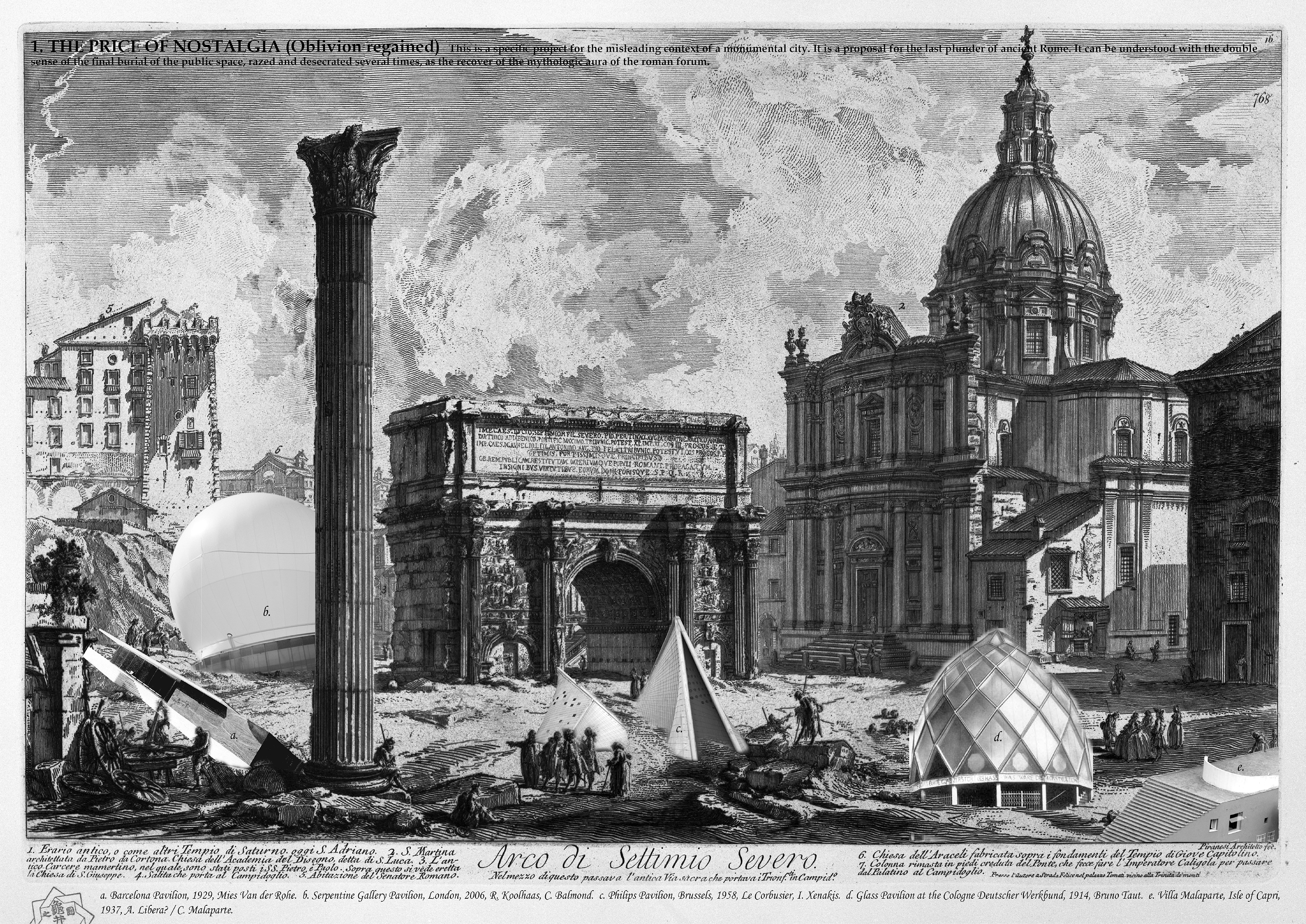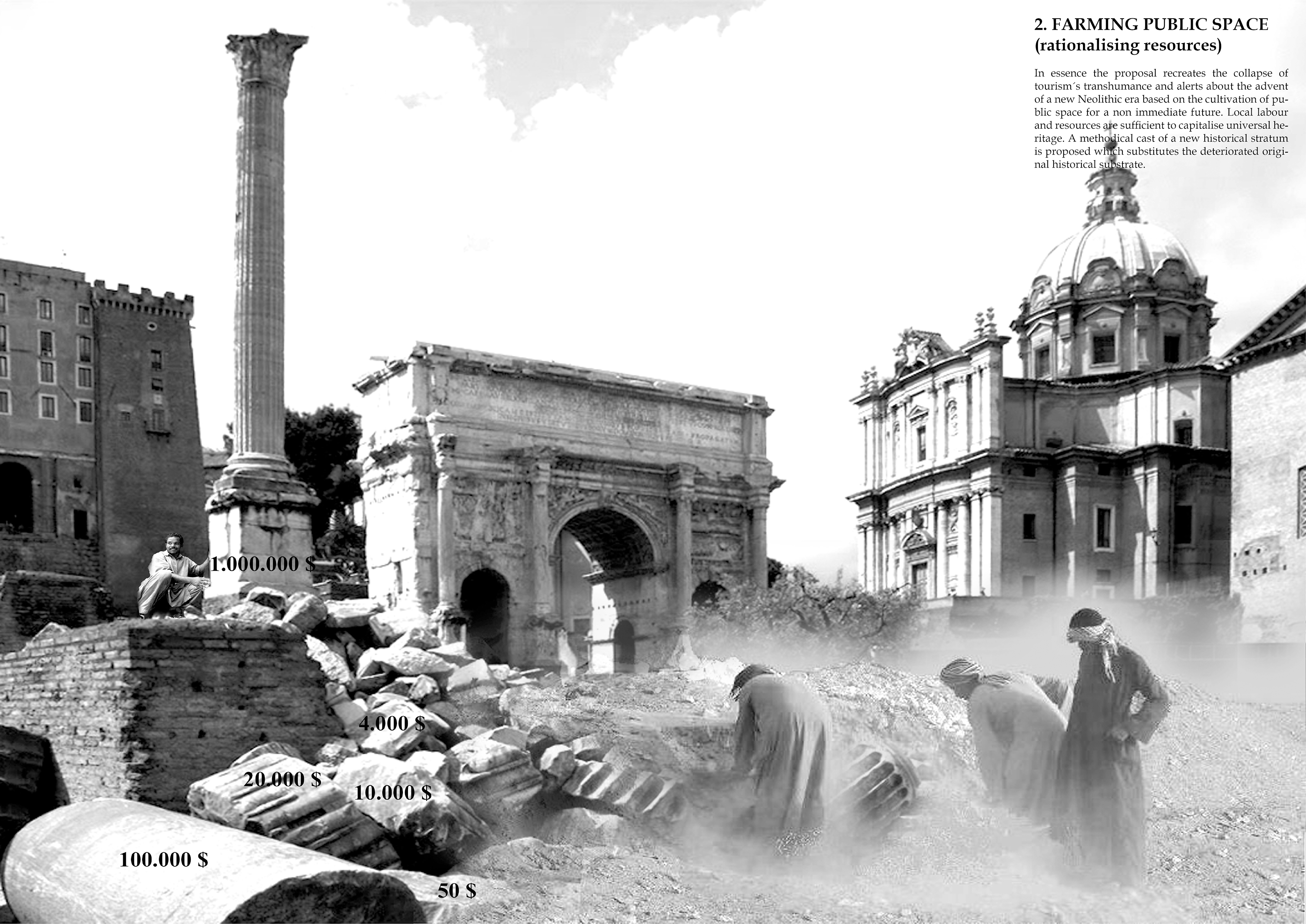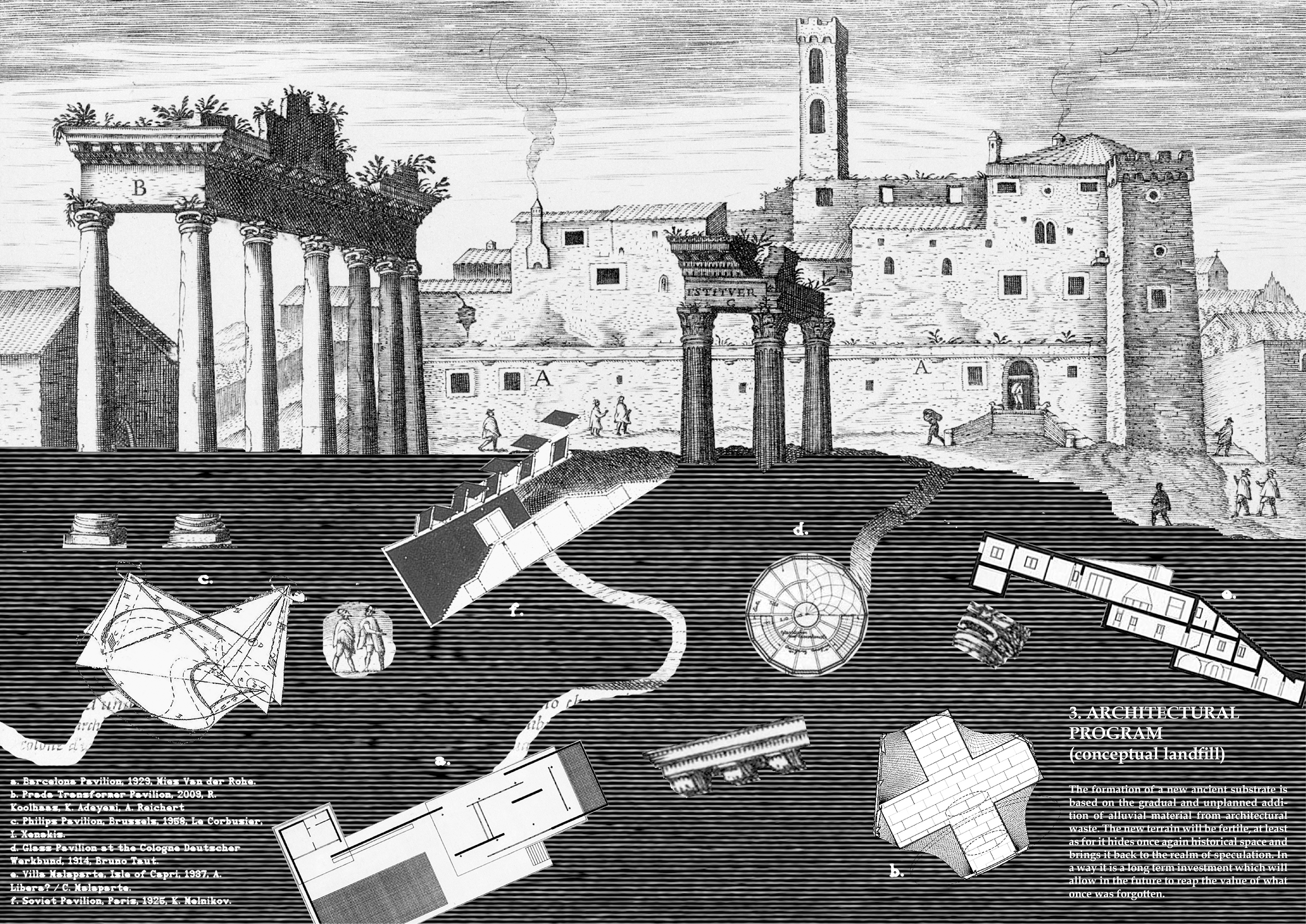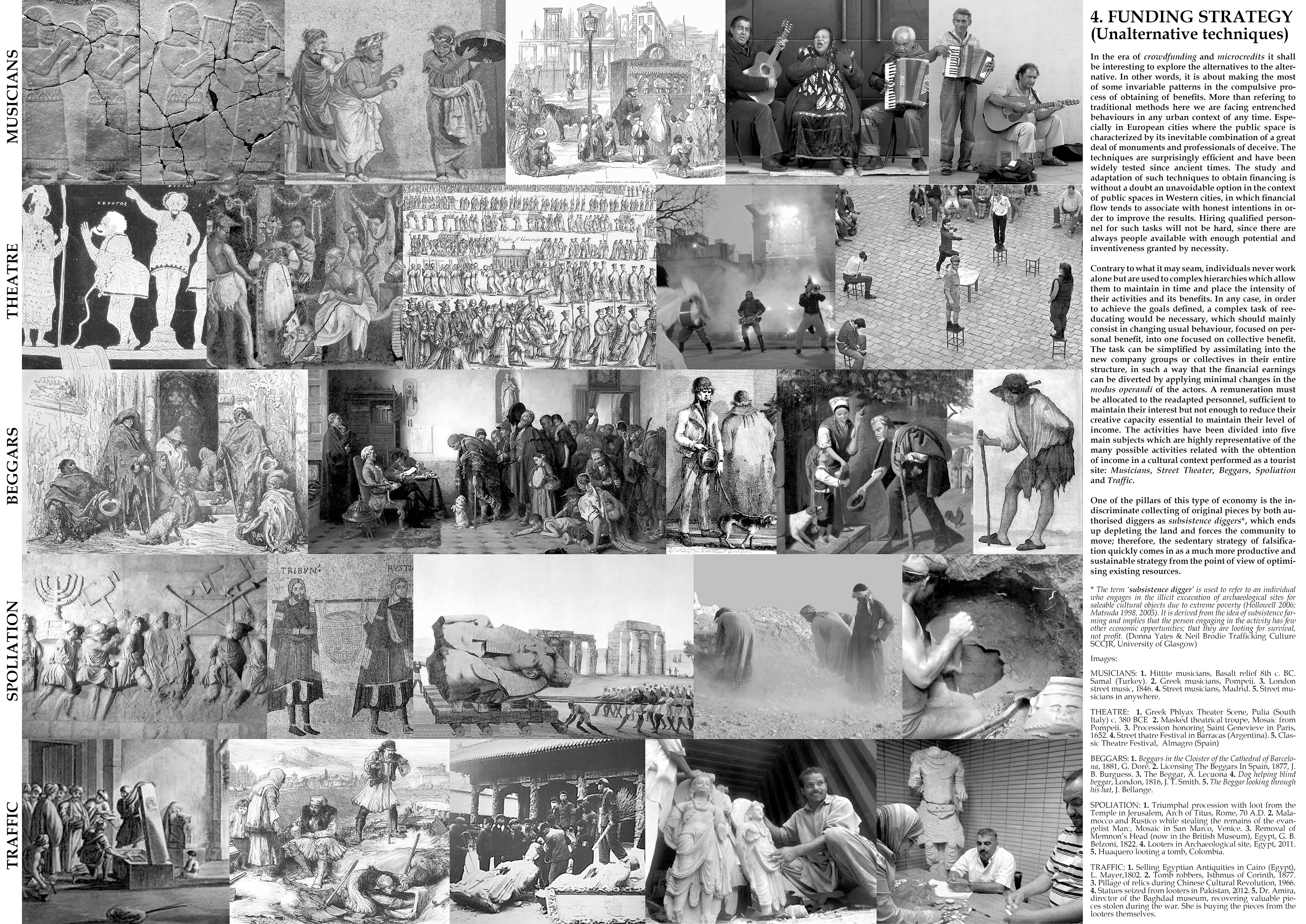
1. THE PRICE OF NOSTALGIA (Oblivion regained): This is a specific project for the misleading context of a monumental city. It is a proposal for the last plunder of ancient Rome. It can be understood with the double sense of the final burial of the public space, razed and desecrated several times, as the recover of the mythologic aura of the roman forum.

2. FARMING PUBLIC SPACE (rationalising resources): In essence the proposal recreates the collapse of tourism´s transhumance and alerts about the advent of a new Neolithic era based on the cultivation of public space for a non immediate future. Local labour and resources are sufficient to capitalise universal heritage. A methodical cast of a new historical stratum is proposed which substitutes the deteriorated original historical substrate.

3. ARCHITECTURAL PROGRAM (conceptual landfill): The formation of a new ancient substrate is based on the gradual and unplanned addition of alluvial material from architectural waste. The new terrain will be fertile, at least as for it hides once again historical space and brings it back to the realm of speculation. In a way it is a long term investment which will allow in the future to reap the value of what once was forgotten.

4. FUNDING STRATEGY (Unalternative techniques): In the era of crowdfunding and microcredits it shall be interesting to explore the alternatives to the alternative. In other words, it is about making the most of some invariable patterns in the compulsive process of obtaining of benefits. More than refering to traditional methods here we are facing entrenched behaviours in any urban context of any time. Especially in European cities where the public space is characterized by its inevitable combination of a great deal of monuments and professionals of deceive. The techniques are surprisingly efficient and have been widely tested since ancient times. The study and adaptation of such techniques to obtain financing is without a doubt an unavoidable option in the context of public spaces in Western cities, in which financial flow tends to associate with honest intentions in order to improve the results. Hiring qualified personnel for such tasks will not be hard, since there are always people available with enough potential and inventiveness granted by necessity. Contrary to what it may seam, individuals never work alone but are used to complex hierarchies which allow them to maintain in time and place the intensity of their activities and its benefits. In any case, in order to achieve the goals defined, a complex task of reeducating would be necessary, which should mainly consist in changing usual behaviour, focused on personal benefit, into one focused on collective benefit. The task can be simplified by assimilating into the new company groups or collectives in their entire structure, in such a way that the financial earnings can be diverted by applying minimal changes in the modus operandi of the actors. A remuneration must be allocated to the readapted personnel, sufficient to maintain their interest but not enough to reduce their creative capacity essential to maintain their level of income.
The activities have been divided into five main subjects which are highly representative of the many possible activities related with the obtention of income in a cultural context performed as a tourist site: Musicians, Street Theater, Beggars, Spoliation and Traffic. One of the pillars of this type of economy is the indiscriminate collecting of original pieces by both authorised diggers as subsistence diggers*, which ends up depleting the land and forces the community to move; therefore, the sedentary strategy of falsification quickly comes in as a much more productive and sustainable strategy from the point of view of optimising existing resources.
* The term ‘subsistence digger’ is used to refer to an individual who engages in the illicit excavation of archaeological sites for saleable cultural objects due to extreme poverty (J. Hollowell / D. Matsuda). It is derived from the idea of subsistence farming and implies that the person engaging in the activity has few other economic opportunities; that they are looting for survival, not profit. (Donna Yates / Neil Brodie, Trafficking Culture SCCJR, University of Glasgow)
Panels 1-4: F. Jorquera / Images panel 4: MUSICIANS: 1. Hittite musicians, Basalt relief 8th c. BC. Samal (Turkey). 2. Greek musicians, Pompeii. 3. London street music, 1846. 4. Street musicians, Madrid. 5. Street musicians in anywhere. THEATRE: 1. Greek Phlyax Theater Scene, Pulia (South Italy) c. 380 BCE 2. Masked theatrical troupe, Mosaic from Pompeii. 3. Procession honoring Saint Genevieve in Paris, 1652. 4. Street thatre Festival in Barracas (Argentina). 5. Classic Theatre Festival, Almagro (Spain) BEGGARS: 1. Beggars in the Cloister of the Cathedral of Barcelona, 1881, G. Doré. 2. Licensing The Beggars In Spain, 1877, J. B. Burguess. 3. The Beggar, A. Lecuona 4. Dog helping blind beggar, London, 1816, J. T. Smith. 5. The Beggar looking through his hat, J. Bellange. SPOLIATION: 1. Triumphal procession with loot from the Temple in Jerusalem, Arch of Titus, Rome, 70 A.D. 2. Malamocco and Rustico while stealing the remains of the evangelist Marc, Mosaic in San Marco, Venice. 3. Removal of Memnon's Head (now in the British Museum), Egypt, G. B. Belzoni, 1822. 4. Looters in Archaeological site, Egypt, 2011. 5. Huaquero looting a tomb, Colombia. TRAFFIC: 1. Selling Egyptian Antiquities in Cairo (Egypt), L. Mayer,1802. 2. Tomb robbers, Isthmus of Corinth, 1877. 3. Pillage of relics during Chinese Cultural Revolution, 1966. 4. Statues seized from looters in Pakistan, 2012. 5. Dr. Amira, director of the Baghdad museum, recovering valuable pieces stolen during the war. She is buying the pieces from the looters themselves.